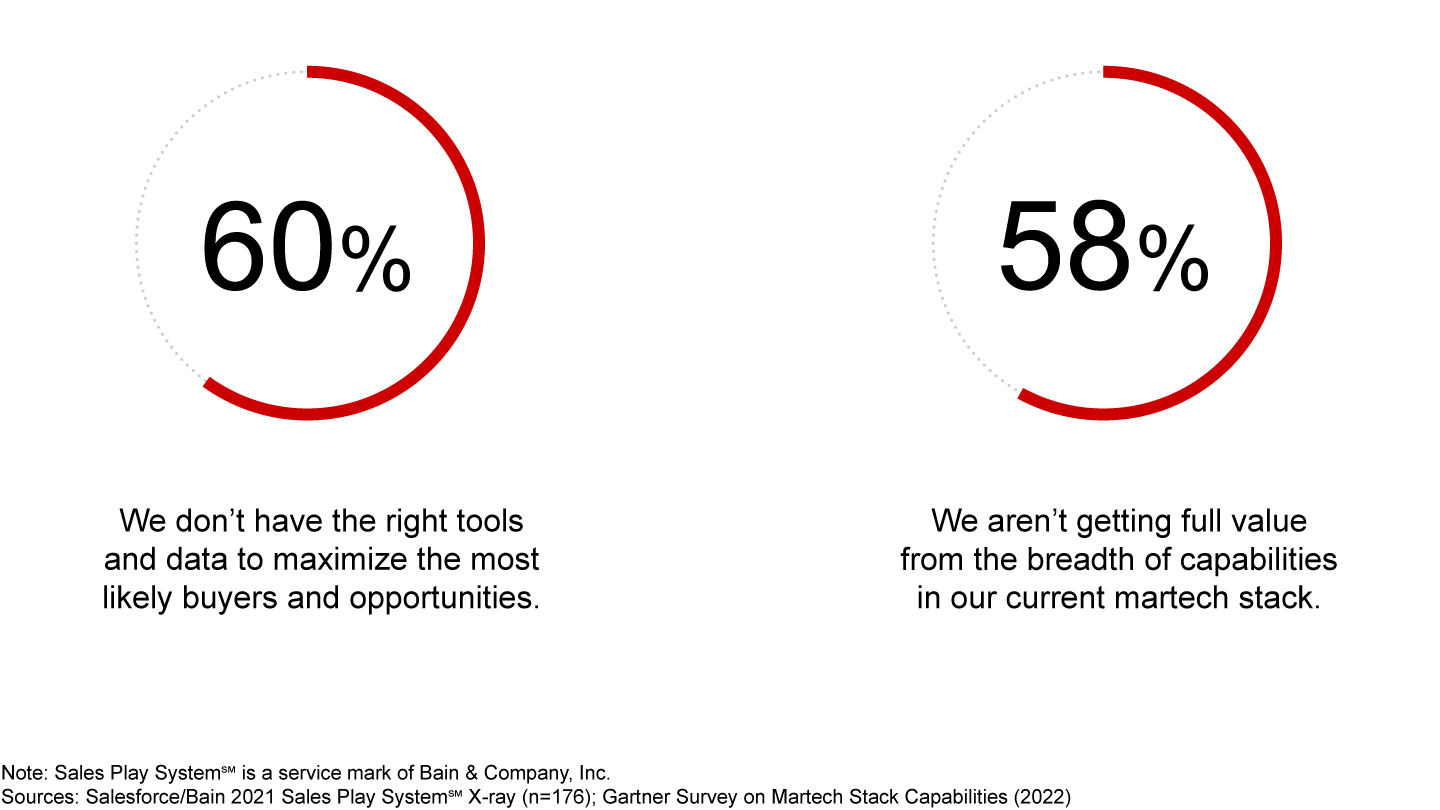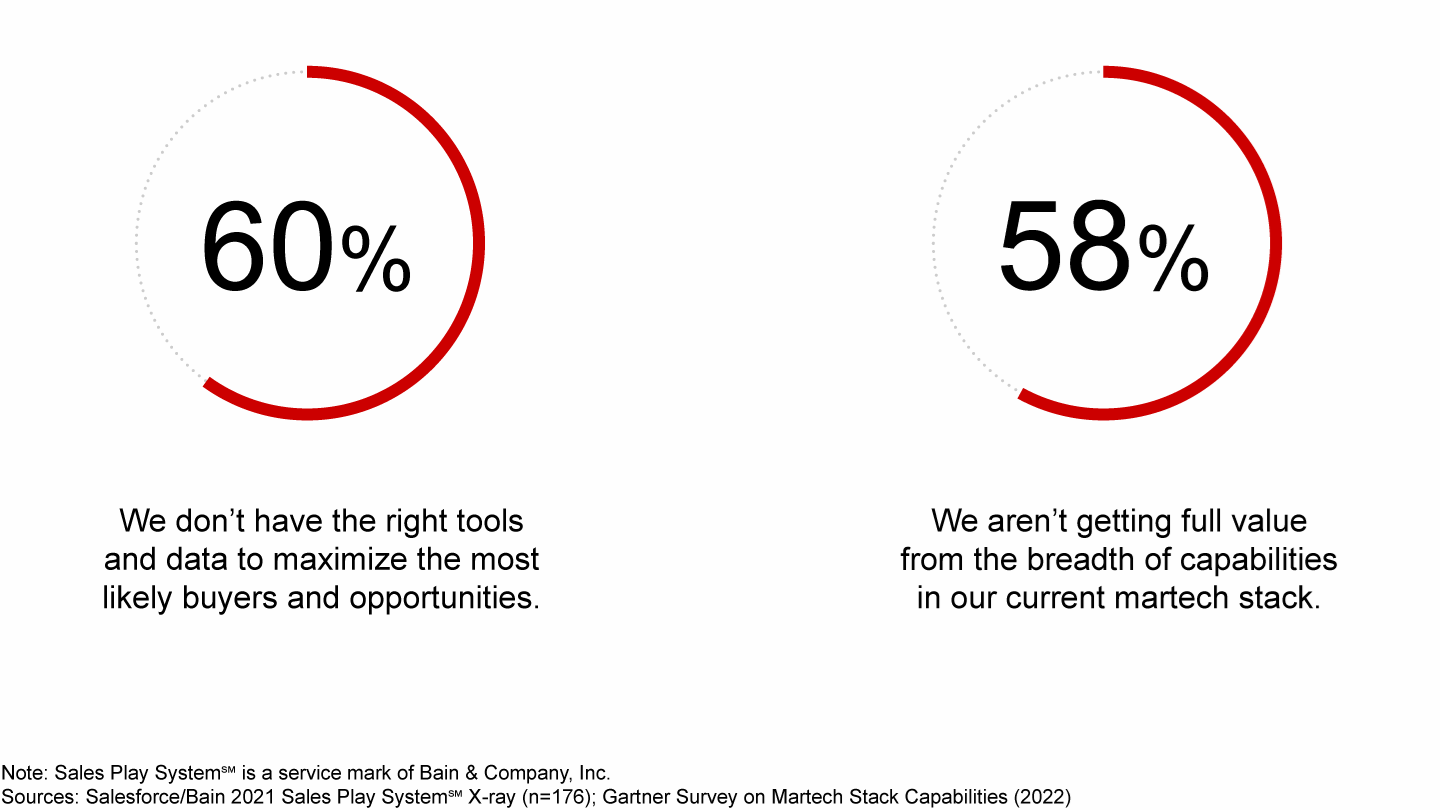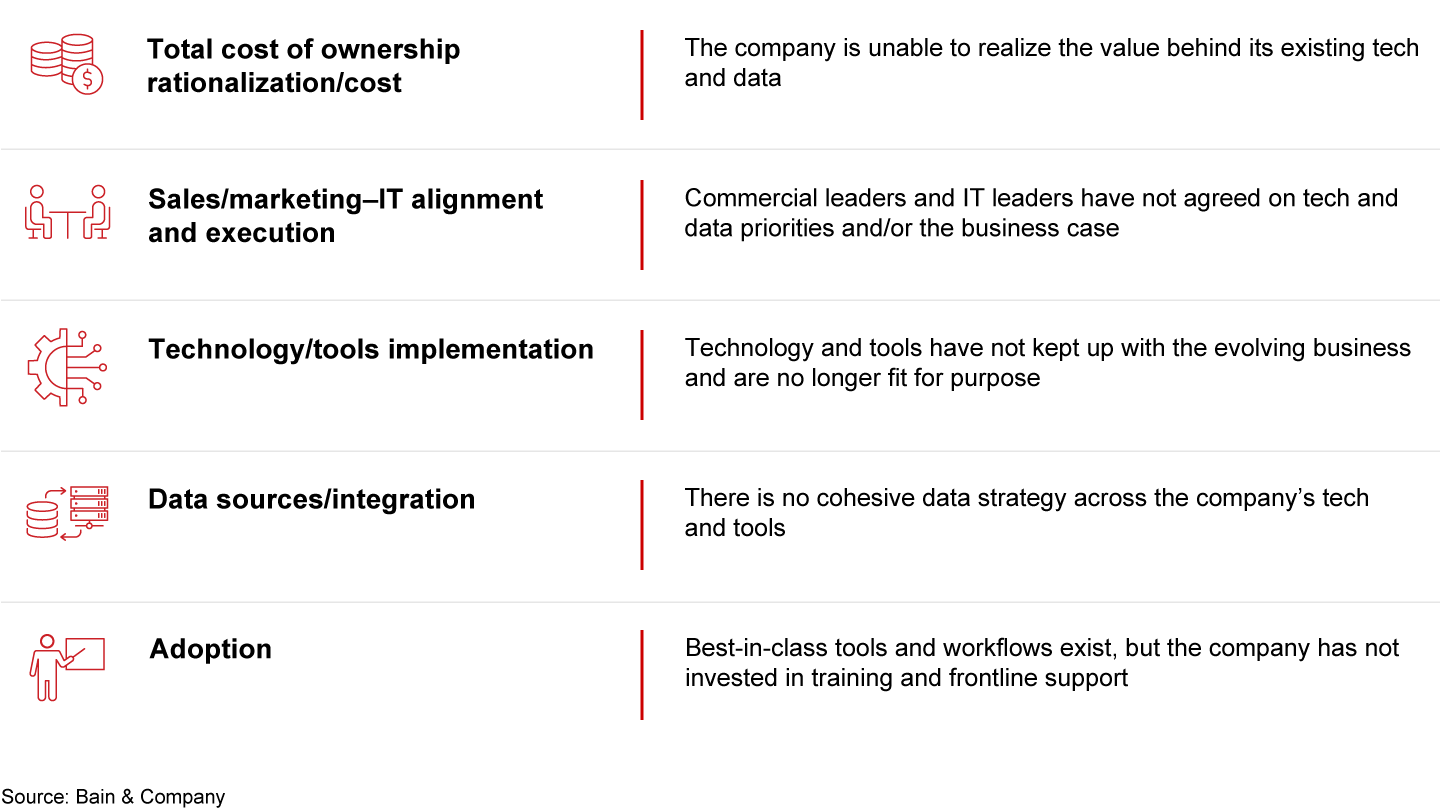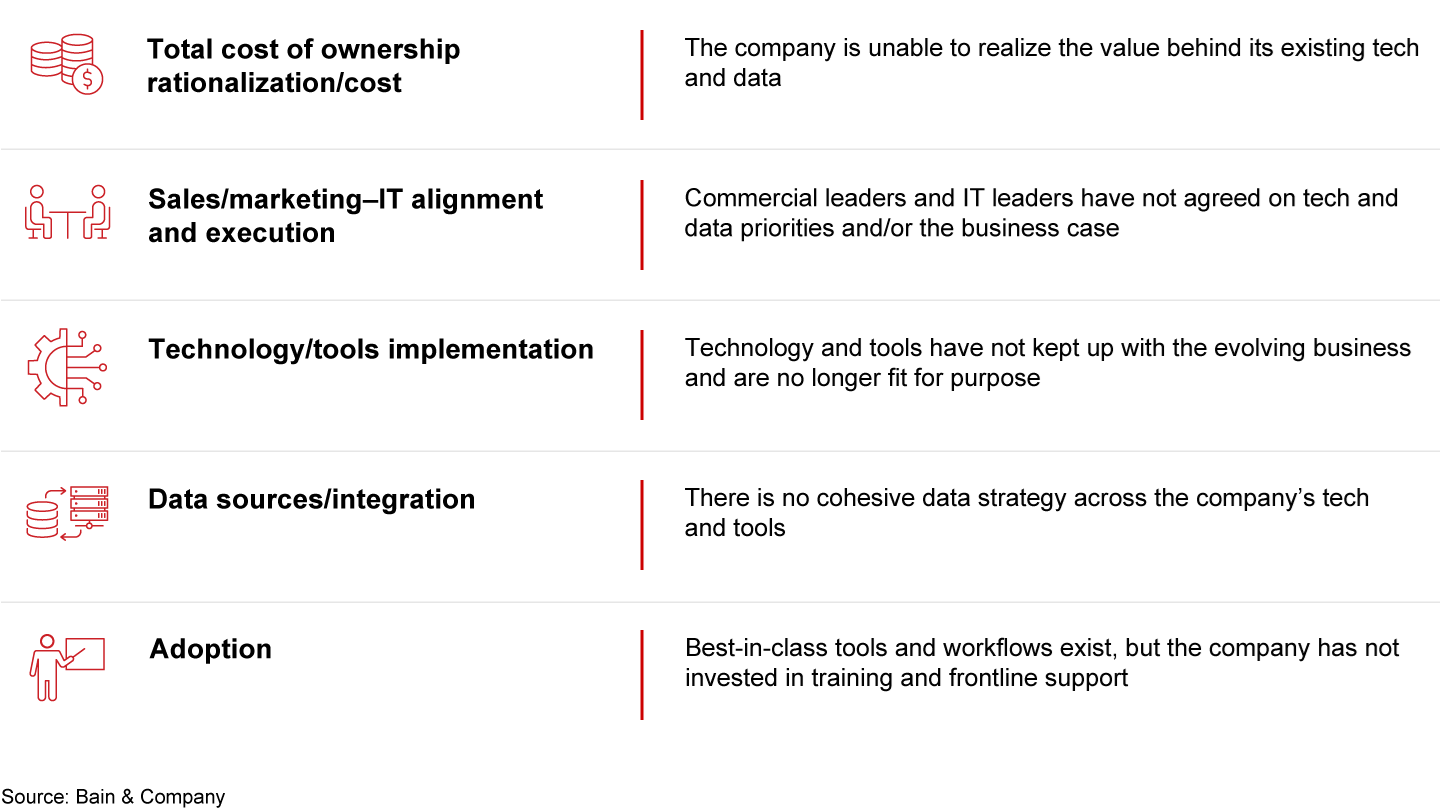Article

At a Glance
- Despite enormous investment in and proliferation of sales and marketing tech, many go-to-market organizations have struggled to effectively use technology and data to boost sales and manage customer relationships.
- As companies shift focus to both growth and productivity, the effective use of commercial technology becomes even more critical to fueling success.
- Business leaders’ go-to-market agendas need to incorporate effective use of technology and data, identify gaps, and create a roadmap in collaboration with their technology teams.
- We apply user-back assessments of your organizational capabilities and the health of your tech and data to produce detailed recommendations that ensure you achieve your sales and marketing goals.
Over the past 5 to 10 years, the array of tools and data solutions available to improve sales and marketing effectiveness has advanced at a breakneck pace that has caught many business leaders by surprise. As leaders shift strategy to embrace a digital agenda, many are struggling with how to prioritize areas to invest, and, at the same time, feeling that their companies aren’t getting enough value from the technology they have already adopted. Most companies have scar tissue from rapid rollouts that resulted in solutions that were never fully adopted, a poor fit, redundant with other tools/processes, or simply disliked by their employees.
The challenge of effectively adopting and integrating these disparate solutions has been greater than many business and IT leaders anticipated—and it is a problem that will become more pressing as the number of technologies and the volume of data inside most organizations continue to grow.
Used appropriately, sales and marketing technologies can help businesses target the right clients, reduce customer acquisition costs, close more deals more quickly, and ensure that frontline and management teams spend the bulk of their time on customer-facing activities. To help their sales and marketing organizations achieve their full potential, business leaders must understand what effective use of commercial technology and data looks like, identify areas of weakness in their own companies, and create and follow a detailed roadmap that will help them to bridge the gap.
Goals and gaps
Most go-to-market leaders intuitively understand how important technology and data are for their organizations to win in the marketplace and outperform their competitors. But the truth is, only a handful of organizations are actually effective at leveraging commercial technology and data (See Figure 1).


This confusion is understandable. With upwards of 10,000 sales and marketing tech tools available, it can be overwhelming to try to cut through the noise. Some organizations got swept up in the digital transformation craze of the past few years without employing an integrated roadmap to guide their efforts. Others raced to deploy tech tools to fuel remote work and enhance efficiency during the pandemic, but now they’re grappling with a hodgepodge of semi-adopted and semi-integrated solutions that aren’t creating maximum value.
In an ideal scenario, the sales and marketing technology stacks will be accelerators for an organization’s most important go-to-market goals. Tools will be implemented with a thoughtful approach to drive successful adoption, and systems will be integrated rather than disparate (and able to leverage different data sources to create insight via a unified “single source of truth”).
However, we see five common areas of gaps experienced by our B2B clients: cost, strategic alignment, implementation, data quality and integration, and adoption (see Figure 2). For instance, we often hear leaders express that they have too many tools to manage, and we frequently observe mutual frustration between go-to-market and IT leaders about lack of alignment on their organizations’ most important business goals. These leaders feel that their systems do not provide real-time insights, that they lag behind best-in-class technology, and that they fail to support the emerging needs of sales and marketing teams.


Even when the right tools are in place, it can be a challenge to get the full potential out of them due to a gap in adoption, as many go-to-market organizations lack an effective training and enablement program that encourages adoption and sustained use over time. “We just delivered an important new solution, and barely anyone is using it,” one business leader told us. “Most people just keep doing things the way they’re used to doing them.”
Getting to good
We have a differentiated approach to assessing organizations’ commercial technology stacks—one that begins with users. Before creating a roadmap to optimize the use of technology and data, we use a human-centered research approach to understand how users approach each work process and what users need to work more efficiently. Then, we identify the hurdles that stand in the way of optimal sales and marketing processes.
Step 1: The vertical
We use what we call a “user-back” approach. We start by mapping a day in the life of organizations’ critical go-to-market roles, developing “cockpits” for each role to illustrate how and where technology and data can help make users more effective in their jobs. This means that we develop a realistic end-to-end understanding of each user’s job in your company, rather than a generic, cookie-cutter projection. Then, we build out a detailed user journey that maps out key activities and outlines the unique needs of each job role.
During this stage, business leaders often begin to see just how much technology and data—when used effectively—can change the way business is done. We work with individual users to understand how tools can make them more productive, and we map out the future state that makes the most sense for them.
STEP 1 IN ACTION: A leading B2B software company was undergoing a transition from a subscription-based model to a consumption-based model, and the organization brought Bain in to analyze its use of commercial technology and data. While the client had existing tech solutions in place, the company was unable to maximize the value of these systems, which also did not meet the emerging needs of the business. We deployed Bain’s Tech Stack X-ray to assess the client’s current tech and data systems, built current-state user journeys, and developed user cockpits for five key user roles based on extensive interviews.
Step 2: The horizontal
Zooming out, we look at how your go-to-market roles fit into the full commercial/customer lifecycle, assessing the health of technology and data across the entire go-to-market organization. Each step in the commercial lifecycle involves multiple users, as well as multiple systems and datasets, and it is critical to understand how these moving parts all fit together (see Figure 3). This stage is about ensuring that technology and data work together to “build bridges” rather than creating “traffic jams.”
STEP 2 IN ACTION: At the B2B software client, we were able to identify a number of specific gaps in the use of sales and marketing technology, leading to “quick wins” and improved long-term outcomes. For instance, the client used word-processing software for tasks that required account management tools, had no codified handoffs between sales and post-sales (which resulted in repeatedly asking customers for the same information), and used cumbersome client-facing processes that forced users to toggle back and forth between tools.
Step 3: The roadmap
Finally, we translate this analysis into a customized roadmap that prioritizes the technology and data improvements most relevant to your go-to-market organization, in alignment with IT. We work closely to not only identify the right tools for the job, but also establish the right process to enable successful installation and execution—a roadmap that meets the unique needs of each organization, on time and within budget.
STEP 3 IN ACTION: For the software client, Bain identified 22 initiatives and conducted rapid decision workshops to align requirements and prioritize initiatives based on business value vs. time to value. This resulted in a prioritized 18-month roadmap agreed by the full management team—with each initiative assigned a defined timeline, owner, and IT sponsor.
Without significant changes, many organizations will continue to miss opportunities to improve customer interactions, make their sales and marketing teams more effective, and ultimately boost revenue. But by tackling this challenge head-on, leaders can transform their commercial technology and data into an incredibly effective force multiplier for their go-to-market teams.